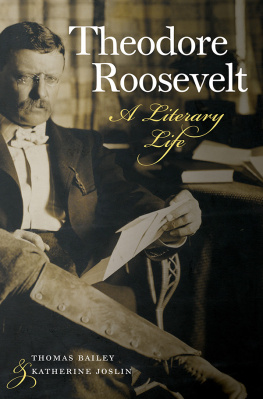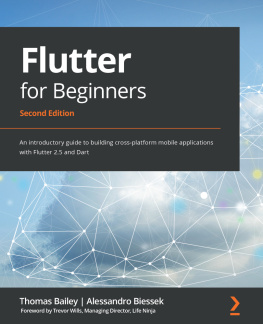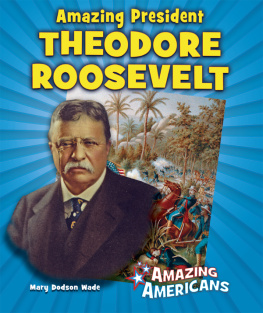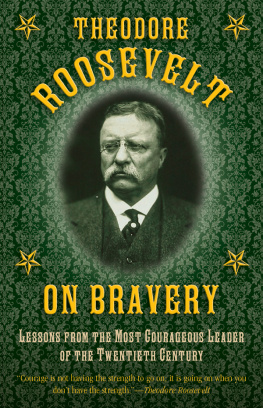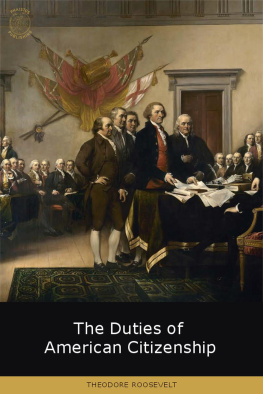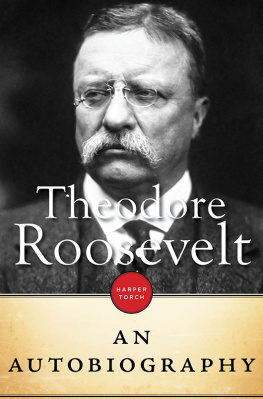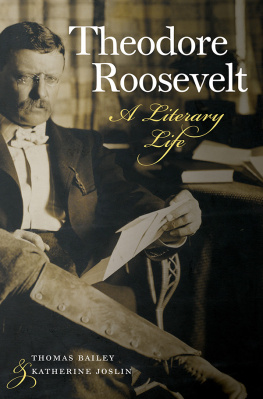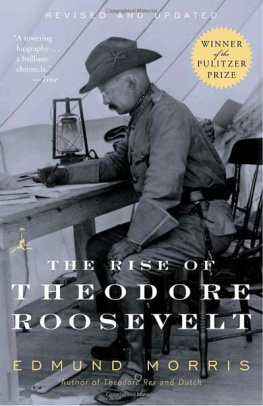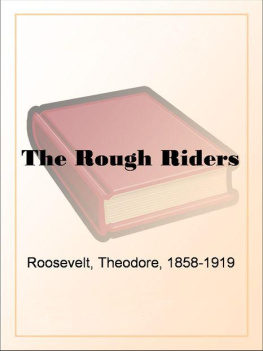
ACKNOWLEDGMENTS
We have worked together over many years and are grateful for the support of institutions and the interest of friends as our book has come into being. Western Michigan University provided Katherine a Faculty Research and Creative Activities Award as well as sabbatical leave that allowed time for scholarly work at the Houghton Library at Harvard University, and at the Library of Congress. The Eccles Centre awarded her a US Fellowship in North American Studies that opened up archives in the British Library.
Early in our research, we were lucky to have the advice of Wallace Finley Dailey, then the curator of the Theodore Roosevelt Collection at Harvard. We add our thanks to those of other Roosevelt scholars over the past forty years who have benefited from Wallaces unfailing expertise and unflagging enthusiasm. We are grateful to his successor Heather Cole and to Pamela Pierce, archivist at the Theodore Roosevelt Center at Dickinson Sate University, for good advice along the way. For generous help, we also thank Mary LeCroy at the American Museum of Natural History, Susan Sarna at Sagamore Hill National Historic Site, Nancy Malloy, archivist at the American Academy of Arts and Letters, and the staffs at the Royal Geographical Society Archives in London and at Bulloch Hall in Roswell, Georgia.
We are grateful to Philip Davies, director of the Eccles Center for American Studies, and his knowledgeable staff in the British Library who led us beyond American shores to think of Roosevelt in the international arena. At the University of Liverpool, we are grateful to fellow Edith Wharton scholar Janet Beer, who is vice chancellor, and her colleague David Seed, for supporting our work on Roosevelt. In England, too, we thank Avril Horner for advice on writing biography, and we are always delighted with the insights of David Woodman and Howard Horner.
Friend and colleague Shirley Clay Scott, former Ruth and Harold Newman Dean of the School of Arts and Sciences at Hunter College, has been steadfast in her support of this project from its very beginning, reading draft after draft, offering invaluable advice, and joining us for an occasional Manhattan. Her colleague Charles Fanning, professor emeritus of history and English at Southern Illinois University, graciously gave us a useful reading of chapters. Carl Smith, professor emeritus of English at Northwestern University, encouraged and advised us as the manuscript grew into a book. Jax Gardiner was an expert research assistant, Rebecca Siegel built a smart and useful index, Glenn Novak worked hard to catch our errors in his copyediting, and Colleen Woolpert made us look good in the photograph. We thank them all.
At the Theodore Roosevelt Symposium in Dickinson, North Dakota, in September 2017, we made the acquaintance of Clay Jenkinson, Sharon Kilzer, Char Miller, Darrin Lunde, and other scholars who are doing fresh and engaging work on Theodore Roosevelt. We wish wed had access in particular to Darrin Lundes fine book, The Naturalist: Theodore Roosevelt, a Lifetime of Exploration, and The Triumph of American Natural History as we were writing this one.
At the University Press of New England, we have been fortunate to have the knowledge and exuberance of our editor Richard Pult, who admitted he is a pushover for Theodore Roosevelt. UPNE is a wonderful place, full of smart and skilled people dedicated to the crafting of books. We are pleased to be publishing with them.
Our yoga friends, Vaughn and Jan Maatman, Kevin Corder and Susan Hoffmann, Brian Wilson and Cybelle Shattuck, and Diana Wilson, seem not to have tired in talking about Theodore Roosevelt. We thank them. Over the long years, we are grateful for good friends with true interest in our writing project; in Michigan, Irma Lpez and Ben Jones; in Vermont, Laurie and Herb Ferris, Michael Maddalena and Rebecca Siegel; and in California, our late friend Jon Strolle, and Barbara and Mel Liner.
Close to home, we thank our children, Cullen and Mike, Kate, Sam, Emily and Jon, and their children, Emily and Dave, Maggie, Clem, Elli, Tom, Cat, and Ivan Rex, and even another generation, Emmet James. Theodore Roosevelt would be proud of such kids; certainly we are.
As our book comes into its own life, we are grateful to be married still and, even, to like each other.
BIBLIOGRAPHY
Writings of Theodore Roosevelt
Papers
Our work comes from research and reading in a variety of places. We have visited and used materials in the Theodore Roosevelt Collection in the Houghton and Widener Libraries at Harvard University; the Theodore Roosevelt Papers in the Manuscript Division of the Library of Congress (also available in microfilm); the American Museum of Natural History in New York City; the Theodore Roosevelt Papers Collection at the Sagamore Hill National Historic Site; the archives at the American Academy of Arts and Letters; the Royal Geographical Society Archives in London; and American collections in the British Library.
The digitization of Roosevelts letters and diaries and journals continues at the Theodore Roosevelt Center at Dickinson State University, Harvards Theodore Roosevelt Collection, the Almanac of Theodore Roosevelt, and the Theodore Roosevelt Association. Online, these sources have been vital to us:
The digital library of the Theodore Roosevelt Center at Dickinson State University. http://www.theodorerooseveltcenter.org/Research/Digital-Library.aspx.
The Theodore Roosevelt Collection in the Houghton Library at Harvard University. http://www.hcl.harvard.edu/libraries/houghton/collections/roosevelt.html.
The Almanac of Theodore Roosevelt. http://www.theodore-roosevelt.com/.
The Theodore Roosevelt Association. http://www.theodoreroosevelt.org/.
Our study is based on digital material and also on these seminal collections of his letters, diaries, journals, and publications:
The Letters of Theodore Roosevelt. 8 vols. Edited by Elting E. Morison, John M. Blum, et al. Cambridge, MA: Harvard University Press, 195154.
The Letters of Theodore Roosevelt and Brander Matthews. Edited by Lawrence J. Oliver. Knoxville: University of Tennessee Press, 1995.
Letters to Kermit from Theodore Roosevelt, 19021908. Edited by Will Irwin. New York: Charles Scribners Sons, 1946.
The Selected Letters of Theodore Roosevelt. Edited by H. W. Brands. New York: Cooper Square, 2001.
Selections from the Correspondence of Theodore Roosevelt and Henry Cabot Lodge, 18841919. New York: Charles Scribners Sons, 1925.
Theodore Roosevelts Diaries of Boyhood and Youth: Illustrated from Photographs and with Facsimiles of the Authors Drawings and Letters. New York: Charles Scribners Sons, 1928.
The Works of Theodore Roosevelt: Memorial Edition. 24 vols. Edited by Hermann Hagedorn. New York: Charles Scribners Sons, 192326.
Books by Theodore Roosevelt
Roosevelts oeuvre continues to be counted and recounted, the Roosevelt Almanac listing fifty-three titles, including juvenilia and policy papers, and the Roosevelt Center listing sixty-six titles, including campaign publications and various works collected and published after his death. John Hall Wheelock in a 1920 bibliography counted sixty-three titles, some of them individual speeches collected in other places. In 2010, Jonathan Nicholas Arnold, in his PhD dissertation, kept the number at thirty-five books written and three coauthored, all published before Roosevelts death. Harvard University is currently working to establish a definitive list, based on the work of former Theodore Roosevelt Collection curator Wallace Finley Dailey, who has worked generously with Roosevelt scholars over many years, and the current curator, Heather Cole, whose bibliography of TRs work is soon to be published. They have relied on the early work of Robert William Glenroie Vail, the first librarian of the Theodore Roosevelt Memorial Association, who put together a considerable file in 1926. No one yet has his count, and he never pushed the daunting details into a complete bibliography. It depends on what you are counting, Cole puts the problem before us.
Next page
